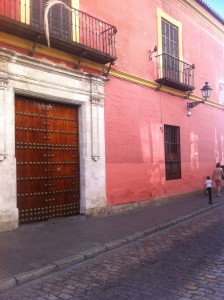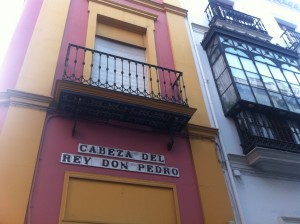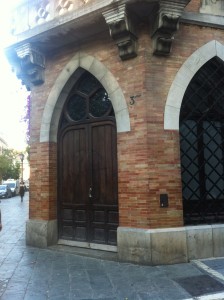It has been a little over a week since I arrived in Seville and I am continually amazed by the beautiful designs and details of all the buildings, parks, and even the streets of the city. I walk everywhere in the city and it doesn’t matter where I am going or what path I take, I am guaranteed to see some tile on the side of a building or a old wooden door. If I get lost while walking around, chances are I won’t end up in some alley filled with dumpsters but instead I will find myself on some cute little street that winds in several directions (sometimes making it hard to know where you are going). I often come across colored stucco houses and plants hanging out the windows. Of course there are the popular sites that are beautiful such as the Alcazar which is a huge royal palace that is 75% gardens or the Plaza de Espana which is a gorgeous semi-circle plaza decorated with endless colorful ceramic tiles. But just as much as these popular sites impress me, so do the everyday details that I see in the city. Below I have included some photos and descriptions about things that have caught my attention and maybe this will give you a better idea about the types of things that cause me call Seville the city of beautiful details. Seville often causes me to point and say “That’s beautiful” or stop and think to myself “That is so pretty”.
The street signs are a beautiful detail that can be found everywhere throughout the city. Most places in the U.S. that have street signs are pretty standard looking with the street name on top of a very large pole. But here in Seville the names of streets are formed out of ceramic tiles and placed on the side/corner of a building. I will admit that sometimes this characteristic doesn’t seem to be the best way to label a street because it is hard to see and especially when you are semi lost. And they don’t seem to always label each streets but none-the-less, I love their non-traditional method of labeling the streets and it gives Seville charm.
A lot of the doors on buildings are made from wood or are a unique, artistic design. It seems that most people live in some sort of apartment building or townhouse type building. Usually the doors to the building are very different from each other in terms of design. One thing that took my friends and I some getting used to was the keys/locks/doors to our house. There really seems to be no standard door/lock and many of them seem complicated. My door has a handle but it is in the middle of the door and it does not turn, it is only for helping to push the door open. Even if the door is “unlocked” you still need the key to be able to turn the padlock and open the door. So we all had quite a few laughs about struggling to open/lock our doors.
Usually when you open the door of the apartment/townhouse building it opens into an enclosed patio with plants or a fountain. This is an architectural design very common in Seville and I think it is so nice to have a patio in the center of your building or house. The patios are usually surrounded by the rooms of the house or individual apartments but have no ceiling so that light can come in. This is how my University building is designed and I love it! I actually don’t have a photo of my University but maybe I will post one later. Also, really large doors to buildings such as churches or convents have smaller doors that open up within the large door. This smaller door is the one that is open most of the time and it big enough for people to walk through. Even though this smaller door is the size of a regular door, it makes me feel like I am in a movie scene or something such as Alice in Wonderland because it is really part of a much larger door. They are so cute and I have included pictures of doors that caught my attention throughout Seville.
 One of the many unique, wooden doors in Seville. If you look closely, you might be able to see where the smaller door is within the large door.
One of the many unique, wooden doors in Seville. If you look closely, you might be able to see where the smaller door is within the large door.
Another door in Seville. It is very possible that the arch of this door is influenced by Muslim architecture since it is similar to other Muslim arch designs present throughout the city. Seville was occupied by Muslims at one point during its historic timeline and several buildings have Muslim architecture characteristics.
Location: Seville, Spain



